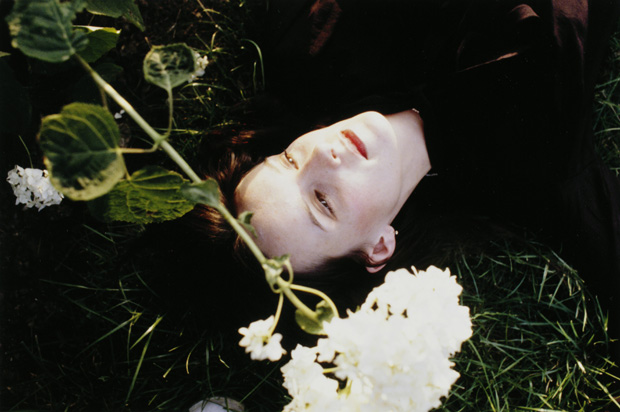by Owen Schaefer
The painful details of Austria-based photographer Seiichi Furuya’s life are not only public, but practically requisite knowledge for viewing his work. Furuya met his wife-to-be Christine Gössler in 1978 while visiting Austria. The couple were married in less than a year, had a son named Komyo in 1981, and then in the autumn of 1985, Christine jumped from their apartment window, killing herself. She had been struggling for many years with severe depression.
Prior to Christine’s death, Furuya’s work had been based on documenting the lives of Europeans, particularly those divided by borders and political-cultural divisions of all kinds. But Christine’s death turned him down an intensely personal path, and he began a slow and painstaking process of developing, editing and organizing the many photos of her he had taken over those few years, even up to the days around her death. As a result, he began to create a complex and ever-changing image of Christine, which he felt, at least in some sense, kept her alive. She would never be reduced to a single static portrait.
Furuya mixes and remixes his images into thematic fleeting memories. And according to the Tokyo Metropolitan Museum of Photography, its current show, Mémoires, is the final installment of two decades of work—a study of memory and photography that explores what happens when a photographer paradoxically begins to work within the confines of events that can no longer be captured on film. What inevitably ignites a fascination with Furuya’s photos is, of course, the knowledge of their tragic narrative. Christine’s death, and the tumultuous life the couple led together, informs the reading of every image. In the “Christine” section of the show, we see an early image from the couple’s first year together: Christine in a mirror, a long crack running unevenly across her face. It is a clichéd image of inner struggle, and faced with what is to come, it seems innocently pretentious. We see Christine later on, lying in the grass with a large bunch of flowers above her, looking like a landlocked Cordelia; then Christine in East Berlin sitting alone at a distance, a car and broken concrete the only things around. The images seem prescient, but of course they are not—a realization which leads one to ponder what tragic images might be found in any collection of personal photos.
But what makes Furuya’s work particularly effective is that he has never been a photographer who attempted to beautify his subjects. There are certainly early shots of Christine looking youthful and beautiful, but they are uncontrived. The images are not tragic because they depict someone unaware of the future, but because they show equal amounts of playfulness, misery, frustration, peace and confusion. Sometimes two images might undercut one another—Christine scowls into the camera in one, while the next reveals her laughing casually in the same pose. Which one came first is unclear, and you are left equally wondering which is more genuine. Was the laugh the result of a joke cracked during a serious moment? Or was the scowl a pretension for the camera? The images both reveal and hide the emotional reality, and we are left to accept both as equally genuine, or accept nothing.
The section devoted to Furuya’s son is an equally curious one. Much of it could be the kind of snapshots anyone would take, but there are surprisingly few. In two particularly unusual images, light has bled into the film, nearly wiping out the image of his wife and son in a park. These are the kind of shots that most photographers would have thrown away. So what is it that makes these two images so precious that Furuya includes them, damaged as they are? Is it the pure scarcity of images of the two of them together that makes them seem golden? Or is it the light flare itself that he cherishes—its harsh reminder of the fragility of memory and moments captured, so easily lost to a tiny crack in the camera case? It is a question that remains unanswered.
Show: Seiichi Furuya: Mémoires (to July 19)
Gallery: Tokyo Metropolitan Museum of Photography (Ebisu station)
Hours: 10am–6pm (to 8pm Thu and Fri, closed Mon)
Admission: ¥800 Tel: 03-3280-0099
www.syabi.com









